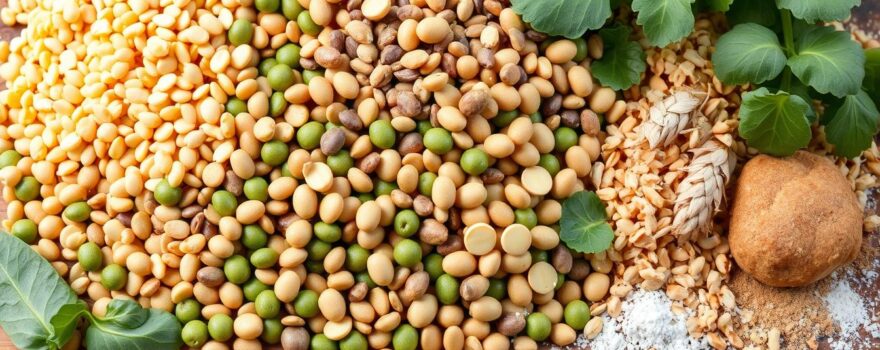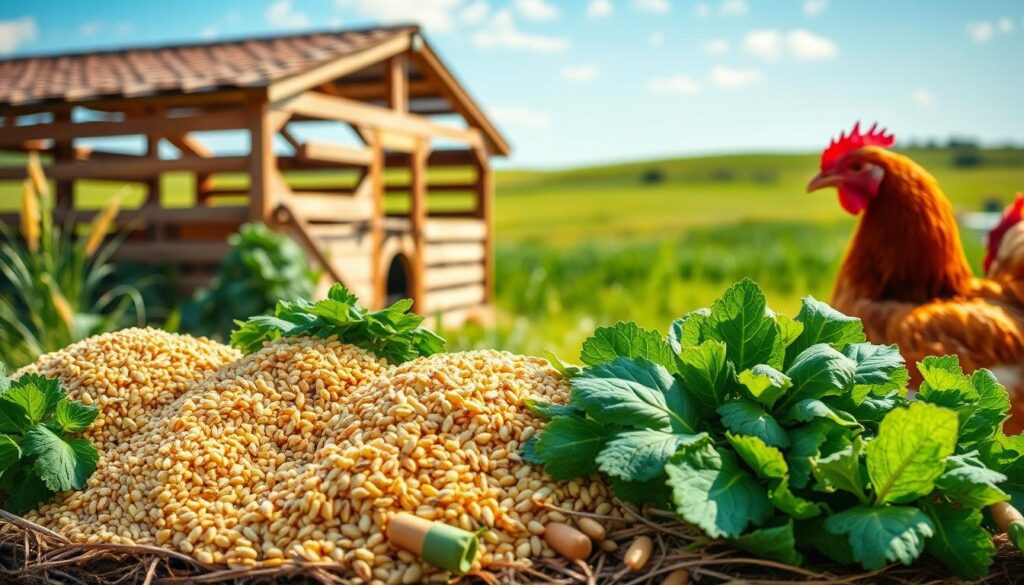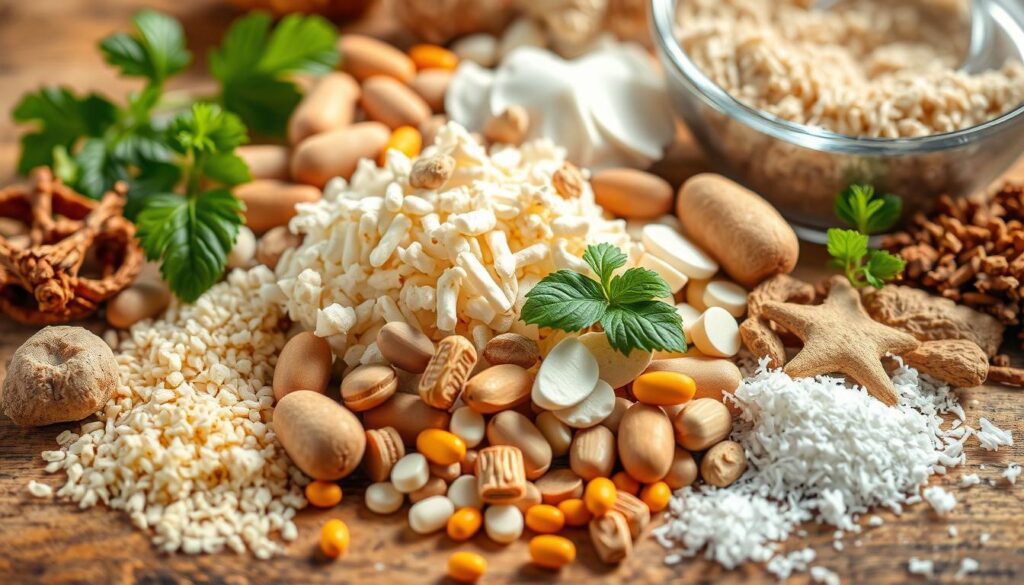
In broiler chicken production, picking the right feed ingredients is key. It affects the birds’ health, how well they eat, and the cost of production. Feed makes up about 70% of the costs, so it’s very important for making money and raising healthy birds.
Choosing the best feed for broiler chickens is complex. It involves looking at the ingredients’ nutritional value, cost, safety, and how they affect the feed’s quality. By carefully picking ingredients, farmers can make feeds that are good for the birds and help them grow fast and strong.
Key Takeaways
- Broiler feed accounts for a significant portion of production costs, making ingredient selection crucial for profitability.
- Evaluating the nutritional value and bioavailability of feed ingredients is essential for optimizing broiler growth and development.
- Understanding the impact of ingredients on feed processing and pellet quality can help ensure efficient feed production.
- Maintaining feed safety and compliance with regulatory standards is vital to protect broiler health and meet consumer demands.
- Exploring cost-effective alternatives and utilizing enzymes can help reduce overall feed expenses while maintaining optimal broiler performance.
Nutritional Aspects of Broiler Feed Ingredients
When it comes to broiler nutrition, it’s key to check the nutrient values and how well they’re absorbed. Looking at crude protein, fat, fiber, and ash gives a basic idea of the feed’s nutritional content. But, it’s the metabolizable energy, digestible amino acids, and available phosphorus that really matter. These elements help support the broiler’s growth and development.
Evaluating Nutrient Values and Bioavailability
Nutrient bioavailability is very important. It shows how well essential nutrients can be used by the broiler. For example, metabolizable energy tells us how much energy the bird can use. Digestible amino acids show how much protein the broiler can make from the feed.
Understanding Nutrient Matrices and Their Importance
Nutrient matrices can change due to many factors like the ingredient’s source, season, and storage. It’s vital to regularly check these matrices. This ensures the feed’s formulation matches the available nutrients, helping the broiler perform its best.
Identifying and Mitigating Anti-Nutritional Factors
Anti-nutritional factors, like tannins, phytates, and trypsin inhibitors, can harm broiler health and performance. It’s important to find and fix these issues. This can be done through enzyme supplements or heat treatments, making the feed safe and effective.
| Nutrient | Typical Range in Broiler Feed | Importance |
|---|---|---|
| Crude Protein | 19-23% | Supports muscle development and growth |
| Metabolizable Energy | 3,000-3,300 kcal/kg | Provides energy for maintenance and production |
| Digestible Amino Acids | Varies by amino acid | Ensures adequate supply of essential amino acids for protein synthesis |
| Available Phosphorus | 0.45-0.55% | Supports skeletal development and bone health |
By carefully looking at the nutritional aspects of broiler feed ingredients, poultry producers can give their birds a balanced diet. This leads to better growth, feed efficiency, and overall flock performance.
Economic Considerations in Ingredient Selection
Broiler producers aim to improve their operations, focusing on the cost of feed ingredients. It’s key to check if ingredients are available and if their prices stay the same all year. Changes in ingredient supply and prices can greatly affect feed costs. So, finding cheaper alternatives is important.
Assessing Ingredient Supply and Pricing Fluctuations
The cost and availability of feed ingredients can change due to seasons, market trends, and global supply chains. Poultry producers need to watch the ingredient supply and price changes closely. This helps them find cheaper options without hurting broiler health.
Exploring Cost-Effective Alternatives and Replacements
At times, it’s smart to swap a pricey ingredient for a cheaper one that’s just as good. This can keep feed costs low and competitive. Looking at nutrient profiles and enzyme applications ensures these swaps don’t harm broilers.
Utilizing Enzymes to Reduce Feed Costs
Using enzymes can cut down on feed costs for broilers. Enzymes make nutrients easier to digest and absorb. This lets producers use less expensive ingredients without losing broiler performance. Enzymes help make feeding more efficient and cost-effective.
“Ingredient selection is not just about nutritional value; it’s also about managing the economic realities of broiler production. By carefully considering supply, pricing, and cost-effective alternatives, producers can optimize their feed programs to maintain profitability.”
How to Choose the Best Feed Ingredients for Broiler Chickens
Choosing the right feed for broiler chickens is all about finding the best mix of nutrients and cost. Relative value (RV) calculations are key here. They help compare nutrients from different sources in detail.
Assessing Nutrient Value Through Relative Value Calculations
Relative value (RV) looks at how much nutrition an ingredient offers. It compares this to a standard. This way, producers can find the most affordable options for their feed.
- Relative value calculations focus on important nutrients like protein, amino acids, energy, and phosphorus.
- By looking at these nutrients across different ingredients, producers can choose the best for their feed. This makes their feed both nutritious and affordable.
- Using relative value calculations helps understand nutrient value better. It’s more than just looking at the price per pound.
Adding relative value calculations to the selection process is smart. It helps ensure broiler chickens get a balanced and affordable diet. This supports their growth and health.
“Relative value calculations are a game-changer in broiler feed formulation, enabling producers to maximize the nutrient bang for their buck.”
Feed Safety and Regulatory Compliance
Keeping broiler feed safe is key for the health of the birds and the safety of the food we eat. It’s important to get feed ingredients from trusted suppliers. They must also go through strict testing and quality checks to avoid chemical, biological, and physical dangers.
Identifying and Mitigating Chemical, Biological, and Physical Hazards
Chemical dangers in broiler feed include pesticides and heavy metals. These can harm the birds. Biological threats like Salmonella or mycotoxins are also risky. Physical hazards, like plastic or metal, can hurt the birds and cause digestive problems. It’s vital to test feed ingredients regularly to find and fix these issues.
Implementing Quality Assurance Methods and Standards
Feed makers need to follow strict quality control steps. This includes using ISO 22000 or HACCP standards. They must check ingredients carefully, test them often, and watch over production and storage. This way, they can make sure the feed is safe and reliable.
Adhering to National and International Regulations
Feed production must follow rules from places like the FDA, USDA, and Codex Alimentarius Commission. Following these rules helps ensure the feed is safe and meets quality standards. This protects both the animals and the people who eat the poultry.
| Hazard Type | Examples | Potential Impacts | Mitigation Strategies |
|---|---|---|---|
| Chemical | Pesticides, heavy metals | Toxicity, reduced growth, and development | Thorough ingredient testing, sourcing from reputable suppliers |
| Biological | Salmonella, mycotoxins | Foodborne illnesses, reduced feed intake, and productivity | Strict sanitation practices, effective heat treatment, and storage conditions |
| Physical | Plastic, glass, metal | Choking hazards, digestive issues, and injuries | Comprehensive screening, equipment maintenance, and foreign object detection |

By focusing on feed safety and following rules, broiler producers can keep their birds healthy. They also make sure the food is safe for people to eat. Using strong quality checks and following standards is key to this.
Impact of Ingredients on Feed Processing and Pellet Quality
The quality of broiler feed pellets is key for better feed processing and nutrient delivery. The type and amount of starch, fat, and fiber in the feed matter a lot. They affect the pellet quality and how well the feed mill works.
Optimizing Conditioning for Starch Gelatinization
Different ingredients have different starch levels and types. They need the right conditioning to gelatinize starch well. This makes the feed easier to digest and the pellets more durable.
Getting the conditioning right, like temperature, moisture, and time, is key. It helps get the most out of starch gelatinization.
Managing Fat and Fiber Content for Pellet Quality
The fat and fiber content in feed ingredients also matters a lot for pellet quality. Too much fat can make pellets less durable. Too much fiber can slow down the feed mill.
Choosing and mixing ingredients with the right fat and fiber content is important. It helps keep the pellets right and makes feed production more efficient.
“Particle size and feed form in broiler diets have been found to impact gastrointestinal tract development and gut health.”
| Ingredient Characteristic | Impact on Feed Processing | Impact on Pellet Quality |
|---|---|---|
| Starch Content and Type | Requires careful conditioning to optimize gelatinization | Affects pellet durability and digestibility |
| Fat Content | Can reduce processing capacity | Can decrease pellet hardness and durability |
| Fiber Content | Can affect processing efficiency | Can impact pellet quality and production rate |
Knowing how feed ingredients affect feed processing and pellet quality helps broiler producers. They can improve their operations, feed efficiency, and flock performance.
Key Ingredients in Broiler Feed Formulation
Making a good diet for broiler chickens needs careful picking of key ingredients. These ingredients work together to give the birds the energy, protein, vitamins, minerals, and fiber they need. This helps them grow, develop, and stay healthy.
Grain Ingredients: Sources of Carbohydrates, Energy, and Fiber
Grains are very important in broiler feed. They are the main source of carbohydrates, energy, and fiber. In the U.S., Brazil, and most of Asia, corn is the main energy source. In Europe, Canada, Australia, New Zealand, and Russia, wheat is the main energy source.
In Australia, sorghum is key during the summer. Barley and rye are used in Scandinavian countries.
Protein Sources: Essential for Muscle Development and Growth
Protein is key for broiler chickens. It helps them build muscles and grow. Oilseed meals like soybean and canola meal make up 20-30% of their diet. Soybean meal has 48% protein and 2,557 kcal/kg of ME.
Canola meal has 37.5% protein and 2,000 kcal/kg of ME. Animal by-products like meat and bone meal and blood meal are also important. They offer 50.4% and 88.9% protein, respectively.
Fats and Oils: Providing Energy and Essential Fatty Acids
Fats and oils are important in broiler feed. They give a lot of energy and essential fatty acids. Vegetable oils like soybean or corn oil are often used. Fish oil is also added to provide omega-3 fatty acids.
Minerals and Vitamins: Crucial for Overall Health and Development
Minerals and vitamins are vital for broiler chickens. They help with many body functions and ensure the birds grow well. Trace minerals like zinc, copper, and manganese are important for metabolism and health.
Fiber: Aiding Digestion and Gut Health
Fiber sources, like soybean dregs, are added to broiler feed. They help with digestion and gut health. Enough fiber helps the birds use nutrients better and keeps their gut healthy.
By balancing these key ingredients, broiler feed can be made to meet the birds’ nutritional needs. This promotes their growth, health, and productivity.
Broiler Feed Ingredients and Ratios
Making the right broiler feed is all about mixing the right ingredients. Each one is important for the chickens’ growth and health. A good feed mix has carbs, proteins, fats, minerals, and vitamins in the right amounts.
A typical broiler feed might have:
- Corn (50%) – the main energy source
- Soybean Meal (25%) – high-quality protein
- Bran (10%) – adds fiber and nutrients
- Fish Meal (5%) – animal protein and vitamins
- Mineral Blend (5%) – for bone and muscle growth
- Vitamin Blends (3%) – boosts health and immunity
- Amino Acid Supplements (2%) – improves protein use
- Fat Sources (0.5%) – increases energy and fatty acids
- Water/Additives (4.5%) – keeps chickens hydrated and adds nutrients
The exact amounts can change based on the chickens’ needs, age, and more. Watching and tweaking the feed mix helps chickens grow better and faster. Joel Salatin’s feed recipes offer great tips on mixing ingredients.
Having a balanced broiler feed is key for their growth, health, and work. It makes for a successful and lasting poultry business.
Additives and Medications in Broiler Feed Formulation
Broiler feed often includes additives and medications to boost performance. These extra ingredients help meet the nutritional needs of these birds. They support protein needs, improve digestion, and keep the birds healthy.
Amino Acids: Supplementing Protein Requirements
Amino acids are key for protein building. Adding them to broiler feed helps meet protein needs for growth and muscle. This ensures broilers get the right nutrients for protein synthesis and using dietary protein well.
Enzymes: Improving Digestibility and Nutrient Absorption
Enzymes are added to improve nutrient digestion and absorption. They break down complex nutrients, helping birds use them better. This leads to better growth, efficiency, and less waste.
Antibiotics: Use Under Veterinary Guidance and Regulations
Antibiotics are used in broiler feed, but only with vet guidance and rules. They help prevent or treat diseases, keeping the flock healthy. But, using antibiotics wisely is key to avoid resistance and ensure food safety.
Adding these ingredients to broiler feed must follow guidelines and rules. This ensures the best performance, safety, and care for the environment.

Mixing and Processing Broiler Chicken Feeds
It’s key to give broiler chickens a balanced diet for their growth. This is done by mixing all feed ingredients well. Special equipment is used for processing and pelletizing the feed.
Ensuring Thorough Mixing for Balanced Nutrition
Good mixing of feed is vital. It makes sure all nutrients, vitamins, and minerals are spread out evenly. This keeps the nutrition consistent and prevents health issues in the chickens.
Using feed mixers helps blend grains, proteins, fats, and more into a uniform mix. This way, every bite of feed is full of nutrients for the chickens.
Specialized Equipment for Feed Mixing and Pelletizing
After mixing, the feed goes through processing and pelletizing. This turns the ingredients into high-quality feed pellets. Special feed production equipment like pellet mills and conditioners are used for this.
The pelletizing process makes the feed better in quality and nutrition. It boosts the bioavailability of nutrients. This can lead to better growth and feed efficiency in broiler chickens.
“Proper feed selection, suited to the age and type of bird, is crucial to prevent health problems and ensure optimal growth and productivity.”
With the right feed mixing and feed processing tools, broiler producers can give a consistent diet. This helps in the health, performance, and profit of their operations.
Quality Control and Inspection of Broiler Poultry Feeds
Keeping broiler feed quality high is key for the health and growth of the birds. It also ensures food safety and boosts production efficiency. Regular checks on broiler feeds are vital to confirm the quality and safety of the ingredients and the final feed.
Regular Quality Inspections for Ingredient Verification
Quality starts with good suppliers. It’s important to check and verify the quality of incoming ingredients. This includes looking at their appearance, physical state, and chemical makeup. Any subpar ingredients should be rejected to show our commitment to quality.
Testing ingredient samples in a trusted lab is crucial. Labs approved by groups like AOAC or AOCS are best. These organizations check the lab’s work to ensure accurate results.
Importance of Quality Control for Broiler Performance and Food Safety
Low-quality feed can harm broiler performance. Studies show that poor pellet quality can cut liveweight by up to 20%. It can also worsen the feed conversion ratio (FCR) by up to 7%. This can cost a lot, with better feed quality potentially saving $3 million a year for 100 million broilers.
Quality feed is also critical for food safety. Good feed quality control and inspection methods are key. They help keep the food supply safe and sound.
“The effectiveness of pellet durability in reducing fines and improving feed quality was highlighted. Grinding of raw materials and conditioning of feed are crucial factors affecting pellet durability.”
Strong quality control and inspection help feed makers meet quality and safety standards. This benefits the health and productivity of the birds. It also improves the quality of the final poultry products.
Choosing the right feed for broiler chickens is key in poultry farming. It affects their health, growth, and how well they do. Knowing what nutrients they need, the cost, and rules helps farmers make smart choices.
Looking closely at what goes into the feed is crucial. This includes grains, proteins, fats, and additives. Using the latest research, like digestible soy protein, can make the feed more effective.
Keeping the feed safe and following rules is also vital. By doing this, farmers can get the best from their birds. This leads to better broiler performance and production efficiency in their broiler feed formulation and ingredient selection.